- By Dan Veaner
- Business & Technology
 Print
Print 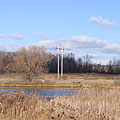 You hear a lot in Tompkins County these days about the need for affordable housing. You also hear a lot about green building. But it never seems like anybody is doing much of anything about it, in large part because of how expensive building is -- especially building green. One Lansing development is innovatively merging an unlikely combination of elements from home building in Ecuador and market-rate house building in Lansing to volunteer builders and reforestation and a free starter solar panel. That will bring down the price considerably for four houses in Farm Pond Circle, a mixed-income community.
You hear a lot in Tompkins County these days about the need for affordable housing. You also hear a lot about green building. But it never seems like anybody is doing much of anything about it, in large part because of how expensive building is -- especially building green. One Lansing development is innovatively merging an unlikely combination of elements from home building in Ecuador and market-rate house building in Lansing to volunteer builders and reforestation and a free starter solar panel. That will bring down the price considerably for four houses in Farm Pond Circle, a mixed-income community."We've discovered that one of the barriers to green building is cost," says Lansing Developer Jack Jensen. "There is pressure to spend your money on square footage, gross size rather than quality. If it appraises for more it's worth more and you get more. There hasn't been an ethos that says it's better to have a 1,400 square foot house that costs no energy than a 5,000 square foot house that costs $10,000 a year to heat. God knows how many BTUs of junk that puts in the atmosphere."
Affording To Build Affordable
Jensen partners with Sheila Squier in managing the not-for-profit Community Building Works (CBW), a kind of privatized Habitat for Humanity. In 2006 Jensen says that four local chapters of Habitat had only managed to build one house, and he wanted to do more. The pair wanted to build new affordable housing and had an idea about using volunteers to keep costs down, but could only do so if they could get not-for-profit 501-C3 certification. Their target would be people at 70% to 80% of the median family income, but the IRS wouldn't allow that. They were looking for people lower on the income scale. Meeting that number would be fiscally impossible in the United States.
On a plane returning from a volunteer build in Ecuador four years ago Jensen realized that they could manage it. Squier and Jensen had just finished working on a house the size of a one car garage for a widow and her four children. The project cost $4,000.
"I thought, this family is broke as can be," Jensen says. "They're poor by any definition. The family that moved into the house that we built was a widow with four children. The light bulb that went off for me was that if we build one house in a foreign country for every one we build here, we'd be killing a bunch of birds with one stone."
Jensen and Squier spent the next year organizing a board of directors, writing bylaws, and building the organization. Their first project was a renovation as general contractor for Ithaca Neighborhood Housing Services (INHS) in 2008. Since then the company has taken on about 40 projects including one brand new house, two major renovations, and smaller jobs. Some are straight contracting jobs such as building a dock that help finance the organization's mission.
Today the company employs Jensen, Squier, Gideon Stone, Nate Litwin, and Sandy Haaf. Jenson does all the design work, development work, and a lot of the building. Stone and Litwin are project managers, and Haaf is the volunteer coordinator and office manager. Squier is the outreach coordinator. So far Squier hasn't drawn salary, and Jensen only recently. But they must find work for their other employees to keep the not-for-profit operating.
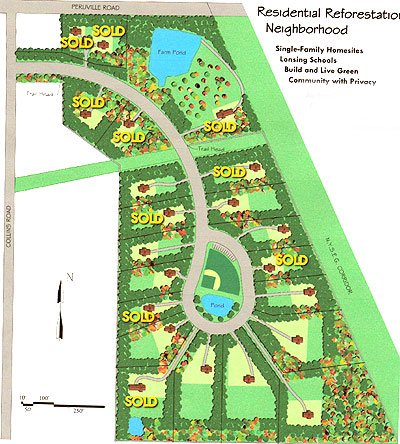 Farm Pond Circle
Farm Pond CircleFarm Pond Circle came about as a response to financial realities of building affordable housing. Jensen spent a year looking for a buildable, decent lot in the Lansing school system for about $20,000. It didn't exist. He wanted to build just one house. So he expanded his search for larger parcels that could then be subdivided. He had two or three in mind. Suddenly he was looking at a 19 home project with the possibility of two more.
"This 48 acres became available," he says. "It was right in the wheelhouse: there was a motivated seller, it's in the Lansing school district, it's very close to the business and technology park. It had a lot of things going for it."
Evolution of a Dream
Originally from Chicago, Jensen has been in the building business for 37 years. He started when he was 17 as a union carpenter in Chicago, and then paid his way through Cornell as an architect. He moved to Lansing in 1978, and opened his own design/build business here after he graduated. In 1992 he realized his client list was all wealthy people who wanted what he calls 'McMansions and starter castles'.
"That wasn't what I had signed up to do," he says. "Somehow I found myself doing that. So I did an about-face and marched into Better Housing for Tompkins County and asked for a job."
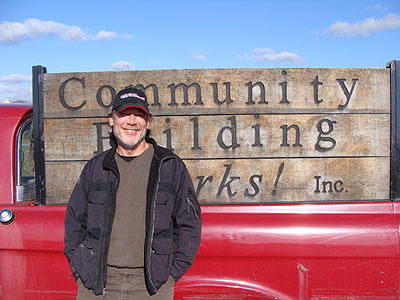 Jack Jensen
Jack JensenHe worked for INHS for three years. Then he worked for Neighborworks, as a national consultant. Neighborworks is a Washington, D.C. based nonprofit organization created by Congress to provide financial support, technical assistance, and training for community-based revitalization efforts. Jensen provided training and technical assistance around the United States. In 2003 he decided to do the same kind of work as a private consultant, and to start his own non-profit to build affordable housing, a long time dream. He continues to do both.
Farm Pond Circle
Community Building Works didn't have the money for a project of this scope, so Jensen is developing it himself. Of the 19 lots currently planned, four will be purchased by CBW for $8,500 a piece. Jensen expects those houses sell $165,000, which he says is affordable to a family of four earning 80% of the median family income.
"That house is undoubtedly worth $225,000," he says. "So there's a deep discount that comes on the backs of our volunteers, and on the backs of our board and volunteer staff. There's not a dollar of state, local, or federal subsidy in that."
The other lots will have market-rate houses, the sale of which will subsidize the CBW projects, and pay Jensen's expenses as developer. Four of those lots are reserved for Jensen's family -- one for a retirement home, one for each of his two daughters, and one rental duplex.
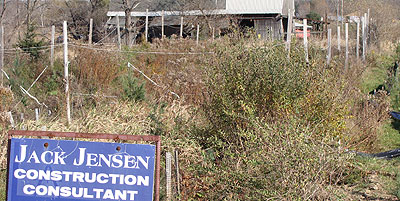 Deer fence protects trees in a nursery near the entrance to the development. As trees grow they are transplanted to reforest nearly 22 acres of the 44 acre development.
Deer fence protects trees in a nursery near the entrance to the development. As trees grow they are transplanted to reforest nearly 22 acres of the 44 acre development.CBW gets a significant discount on the lots, paying $7,500 while some other lots are going for $35,000. Jensen will build a minimum of eight of the houses: the four for his family and the four for the non-profit CBW. He is available for hire to build the other houses, but has not made that a requirement of buying properties in the development. However there are deed restrictions on all the properties to make them green.
While the four CBW houses will be relying heavily on volunteer labor and donations so they will be be valued at more once they are sold. That will create a diverse community that, in a way, will be a microcosm of Lansing itself.
"It's a mixed income community," Jensen says. "Every study that I've seen has shown that kids do better in mixed income communities than in pockets of poverty that these big projects create."
Located in the crook of Peruville and Collins Roads, the community will boast a walking trail along the perimeter, a combination baseball and soccer field, ponds, and lots and lots of trees. It is virtually within walking distance of the Xtramart and the new grocery store that is scheduled to open next Spring, making it close to the future Lansing center.
Building Green
Of the original 48 acres about 22 acres will be permanently re-forested. To facilitate that volunteers helped create a nursery near the entrance to the property where 1,000 seedlings were planted. Volunteers have been transplanting the seedlings along the roadway and into areas they know will not have to be bulldozed.
To the north evergreens will provide a wind breaker and privacy shield. The south of each lot will remain open to take best advantage of the sun for solar houses. To make that work the lots designs are staggered, with deciduous trees on one side and open space on the other, then the reverse on the next lot, and so on. That will provide privacy and light for every lot, plus shade to mitigate overheating in the summer.
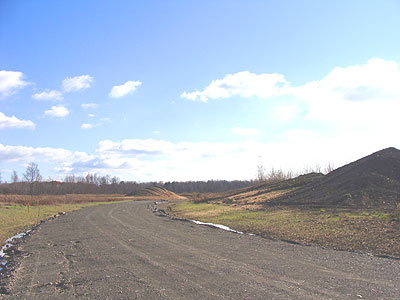 This road ends in a circle in which a combination baseball/soccer field will be located
This road ends in a circle in which a combination baseball/soccer field will be locatedThe deed restrictions also require no more than 2,600 square feet of heated area per house. CBW has been creating partnerships with key suppliers including a solar energy supplier, The Plantsmen nursery, Baker-Miller Lumber for a Marvin window and door package, and Hearth and Home for wood burning stoves.
"I think this makes it easier for the ordinary person to access a green house," Jensen says. "It gives them the opportunity to build green because they have their own acre and a half or so. We're requiring that the houses meet Energy Star compliant, which is about 20% over code. There is a cost involved, but a rebate pays for the cost. In the end you have a much more energy-efficient house."
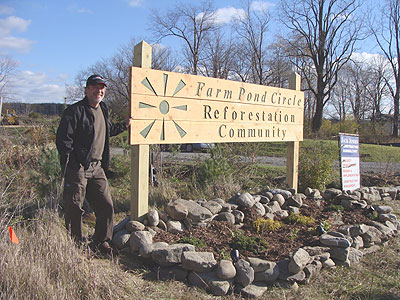
Jensen says his favorite part of the project is working with volunteers and planting trees.
"I like building forests," he says. "It's fun to do. My second favorite has been thinking through the various green aspects. I love building with volunteers. That's a blast. The empowerment is incredible, especially with some of the older volunteers."
----
v6i45



